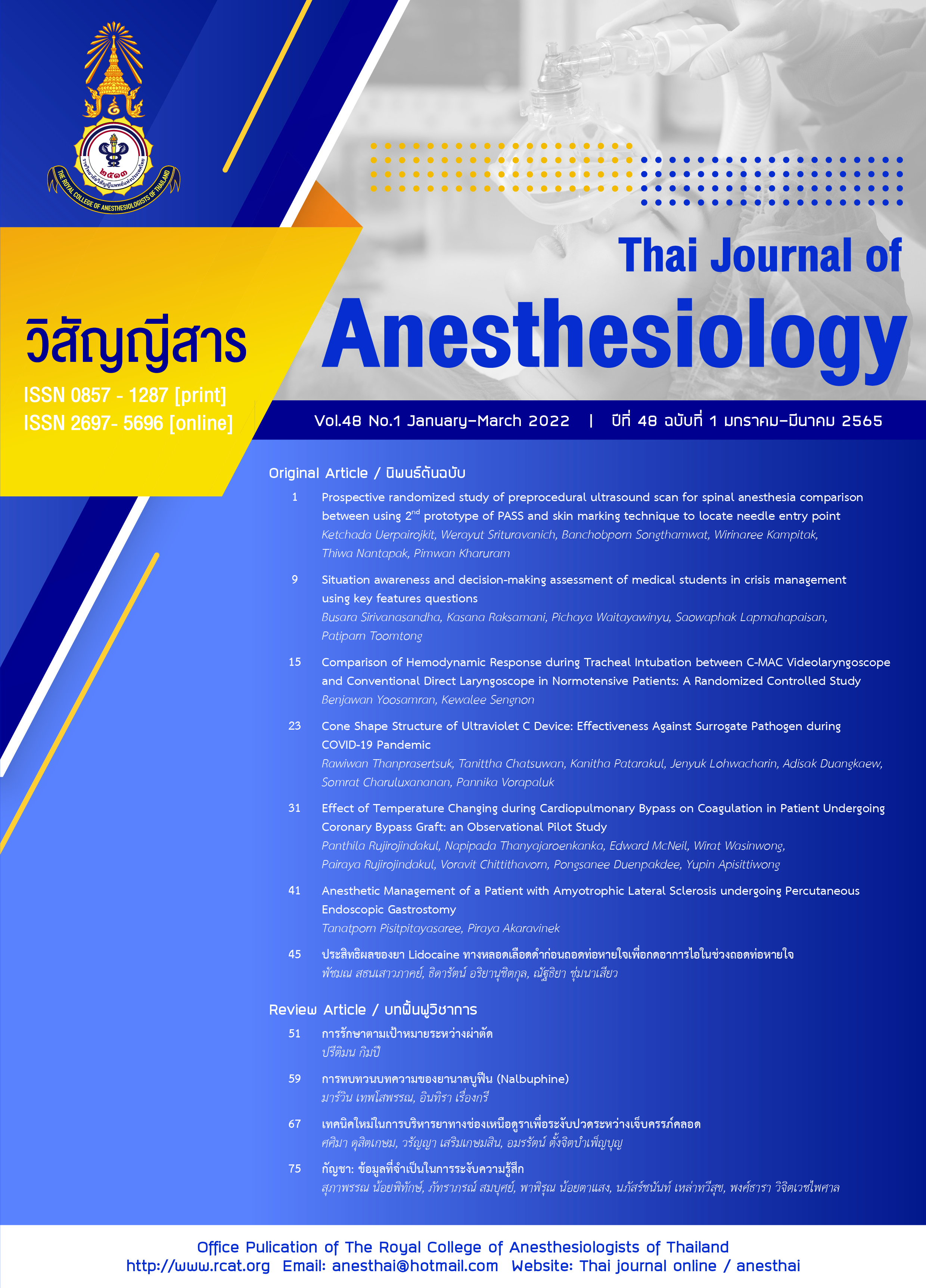Prospective randomized study of preprocedural ultrasound scan for spinal anesthesia 1 comparison between using 2nd prototype of PASS and skin marking technique to locate needle entry point
Main Article Content
บทคัดย่อ
Background: Pre-procedure ultrasound scans can indicate the midpoint of the puncture site of spinal injection. However, there are limitations of the technic. Objectives: To compare the success rate of spinal anesthesia by preprocedural ultrasound scan to compare 2 needle puncture technics between using Point-Assisted Spinal Sonography (PASS) and skin marking. Methods: Forty-eight patients undergoing elective spinal anesthesia were randomized to receive preprocedural ultrasound scan with transverse interspinous view to locate the needle puncture, using either the 2nd prototype of PASS (n=24) or skin marking (conventional) (n=24). The conventional technic was done by making the intersection point of the two lines across the short and long edges of the transducer, whereas the other used PASS to guide the needle trajectory. The primary outcome was the success rate of spinal tap at the first attempt. The number of total attempts and spinal tap duration to obtain the CSF were recorded as secondary outcomes. Results: The success rate of spinal tap at the first attempt was 9/24 (37.5%) patients in PASS and 11/24 (45.8%) in skin marking group (P=0.55). Spinal tap duration and the number of total attempts were not statistically different (P=0.55 and 0.49 respectively). Conclusion: The 2nd prototype of PASS produces comparable successful spinal block with using skin marking technic in terms of success rate at the first attempt and procedure time. Needling without marks or gel in PASS technic might take less risk of intrathecal contamination.
Article Details

อนุญาตภายใต้เงื่อนไข Creative Commons Attribution-NonCommercial-NoDerivatives 4.0 International License.
เอกสารอ้างอิง
Chin KJ, Perlas A, Chan V, Brown-Shreves D, Koshkin A, Vaishnav V. Ultrasound imaging
facilitates spinal anesthesia in adults with difficult surface anatomic landmarks. Anesthesiology 2011;115:94-101.
de Filho GR, Gomes HP, da Fonseca MH, Hoffman JC, Pederneiras SG, Garcia JH. Predictors of successful neuraxial block: a prospective study. Eur J Anaesthesiol 2002;19:447-51.
Balki M, Lee Y, Halpern S, Carvalho JC. Ultrasound imaging of the lumbar spine in the transverse plane: the correlation between estimated and actual depth to the epidural space in obese parturients. Anesth Analg 2009;108:1876-81.
Kampitak W, Werawatganon T, Songthamwat B. Paramedian Spinal Anesthesia: Landmark vs. Ultrasound-guided Approaches. J Anesth Clin Res 2018;9:1000837.
Chin KJ, Ramlogan R, Arzola C, Singh M, Chan V. The utility of ultrasound imaging in predicting ease of performance of spinal anesthesia in an orthopedic patient population. Reg Anesth Pain Med 2013;38:34-8.
Hampl K, Steinfeldt T, Wulf H. Spinal anesthesia revisited: toxicity of new and old drugs and compounds. Curr Opin Anaesthesiol 2014;27:549-55.


